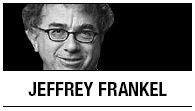CAMBRIDGE ― With November’s election in the United States fast approaching, the Republican candidates seeking to challenge President Barack Obama claim that his policies have done nothing to support recovery from the recession that he inherited in January 2009. If anything, they claim, his fiscal stimulus, the bank bailouts, and U.S. Federal Reserve Chairman Ben Bernanke’s aggressive monetary policy made matters worse.
Obama’s Democratic defenders counter that his policies staved off a second Great Depression, and that the US economy has been steadily working its way out of a deep hole ever since. Middle-ground observers, meanwhile, typically conclude that one cannot settle the debate, because one cannot know what would have happened otherwise.
There is a good case to be made that government policies ― while not strong enough to return the economy rapidly to health ― did halt an accelerating economic decline. But the middle-ground observers are right that one cannot prove what would have happened otherwise. It is also true that it is rare for a government’s policies to have a major impact on the economy immediately.
But here is the remarkable thing: whether one listens to the Republicans, the Democrats, or the middle-ground observers, one gets the impression that economic statistics show no discernible improvement around the time that Obama took office. In fact, the reality could hardly be more different.
This is especially true if one looks at revised data, which show the U.S. economy to have been in far worse shape in January 2009 than was reported at the time. In January 2009, the annualized growth rate in the second half of 2008 was officially estimated to have been -2.2 percent; but current figures reveal the contraction to have been much sharper ― a horrendous -6.3 percent. This is the main reason why economic activity in 2009 and 2010 was so much lower than had been forecast ― and why unemployment was so much higher.
The maximum rate of economic contraction ― a veritable freefall ― came in the last quarter of 2008. More specifically, according to the monthly GDP estimates from the highly respected forecaster Macroeconomic Advisers, it came in December ― the month before Obama was inaugurated. As the graphs below plainly show, the growth trajectory miraculously reversed as soon as Obama’s term began, yielding a clear “V” pattern in 2008-09.
The full force of the fiscal stimulus package began to go into effect in the second quarter of 2009, with the U.S. National Bureau of Economic Research officially designating the end of the recession as having come in June of that year. Real GDP growth turned positive in the third quarter, but slowed again in late 2010 and early 2011, which coincides with the beginning of the withdrawal of the Obama administration’s fiscal stimulus.
Other economic indicators, such as interest-rate spreads and the rate of job loss, also turned around in early 2009. Labor-market recovery normally lags behind that of GDP ― hence the “jobless recoveries” of recent decades. But official data on monthly job losses and gains reveal an obvious V-shape here, too: as the graph below shows, the end of the free-fall for private-sector employment came precisely when Obama was inaugurated.
Again, such data do not demonstrate that Obama’s policies yielded an immediate payoff. In addition to the lags in policies’ effects, many other factors influence the economy every month, making it difficult to disentangle the true causes underlying particular outcomes.
Given that difficulty, the right way to assess whether the fiscal stimulus enacted in January 2009 had a positive impact is to start with common sense. When the government spends $800 billion on such things as highway construction, salaries for teachers and policemen who were about to be laid off, and so on, it has an effect. Workers who otherwise would not have a job now have one, and may spend some of their income on goods and services produced by other people, creating a multiplier effect.
Those who claim that this spending does not boost income and employment (or that it causes harm) apparently believe that as soon as a teacher is laid off, a new job is created somewhere else in the economy, or even that the same teacher finds a new job right away. Neither can be true, not with unemployment so high and the average spell of unemployment much longer than usual.
They also believe that the government deficit drives up inflation and interest rates, thereby crowding out other spending by consumers and firms. But interest rates are at rock-bottom levels ― even lower than in January 2009 ― while core inflation has slowed to a pace unseen since the early 1960s. The conditions of the last four years ― high unemployment, depressed output, low inflation, and low interest rates ― are precisely those for which traditional “Keynesian” remedies were designed.
Economists’ more sophisticated forecasting models also show that the fiscal stimulus had an important positive effect, for much the same reasons as the common-sense approach. The non-partisan U.S. Congressional Budget Office reports that the 2009 spending increase and tax cuts gave a positive boost to the economy, and indeed had the extra multiplier effects predicted by traditional Keynesian models. Allowing for a wide range of uncertainty, the CBO estimates that the stimulus added 1.5-3.5 percent to GDP by the fourth quarter, relative to where it otherwise would have been. The boost to 2010 GDP, when the peak effect of the stimulus kicked in, was roughly twice as great.
Of course, econometric models do not much interest most of the public. A turnaround needs to be visible to the naked eye to impress voters. Given this, one can only wonder why basic charts, such as the 2008-2009 “V” shape in growth and employment, have not been used ― and reused ― to make the case.
By Jeffrey Frankel
Jeffrey Frankel is professor of capital formation and growth at Harvard University. ― Ed.
(Project Syndicate)






![[Graphic News] More Koreans say they plan long-distance trips this year](http://res.heraldm.com/phpwas/restmb_idxmake.php?idx=645&simg=/content/image/2024/04/17/20240417050828_0.gif&u=)